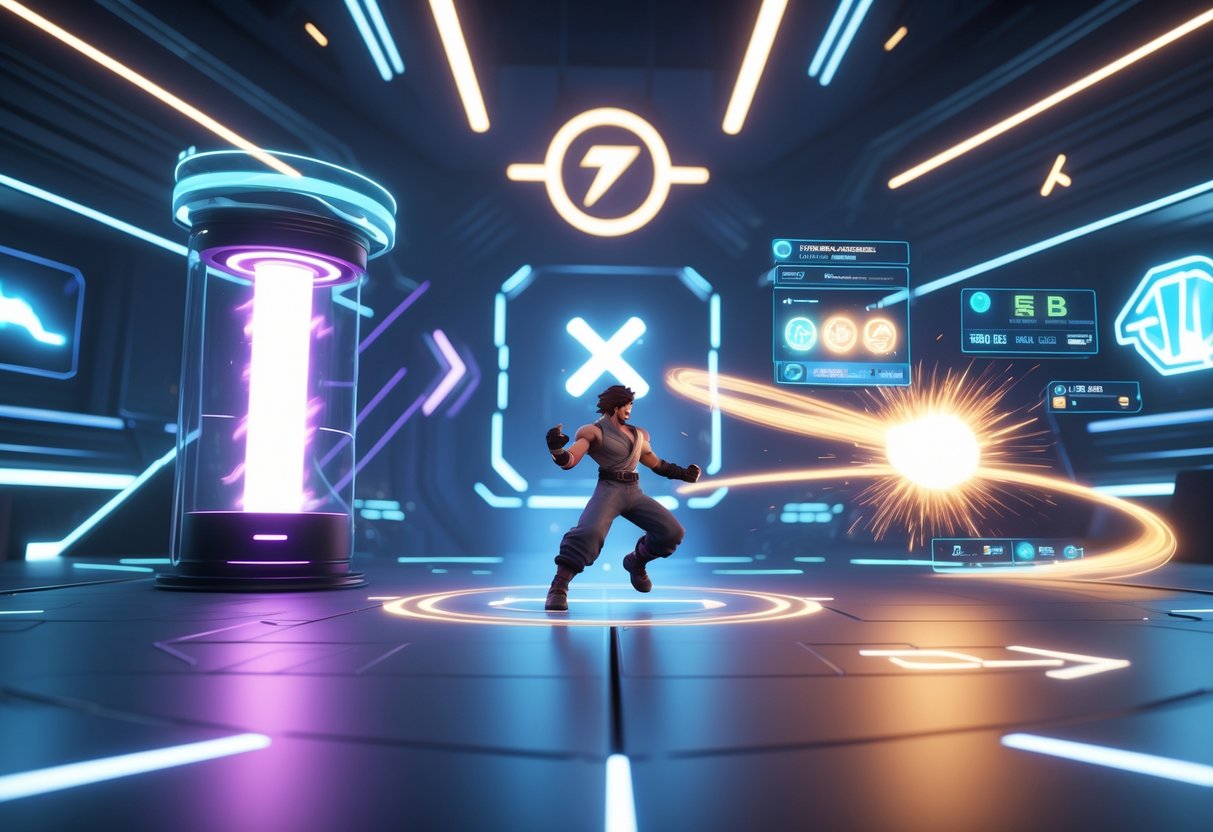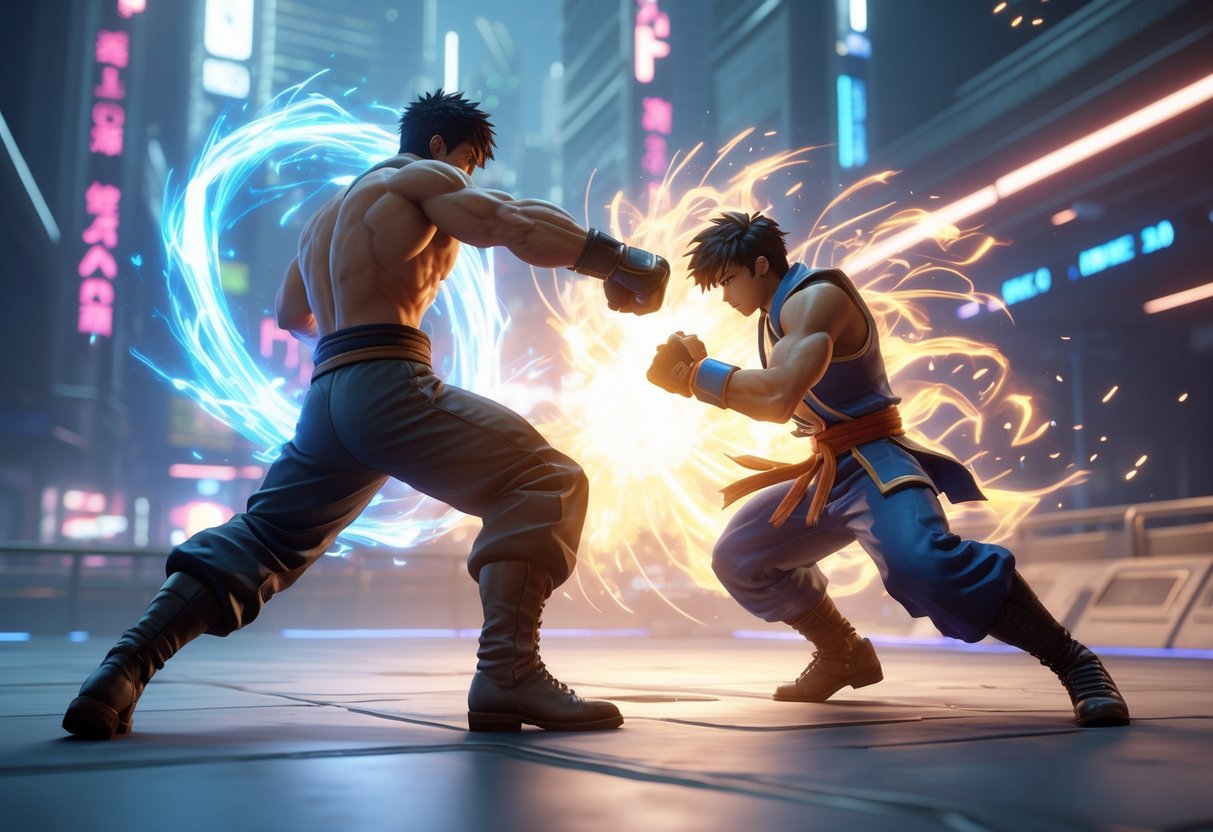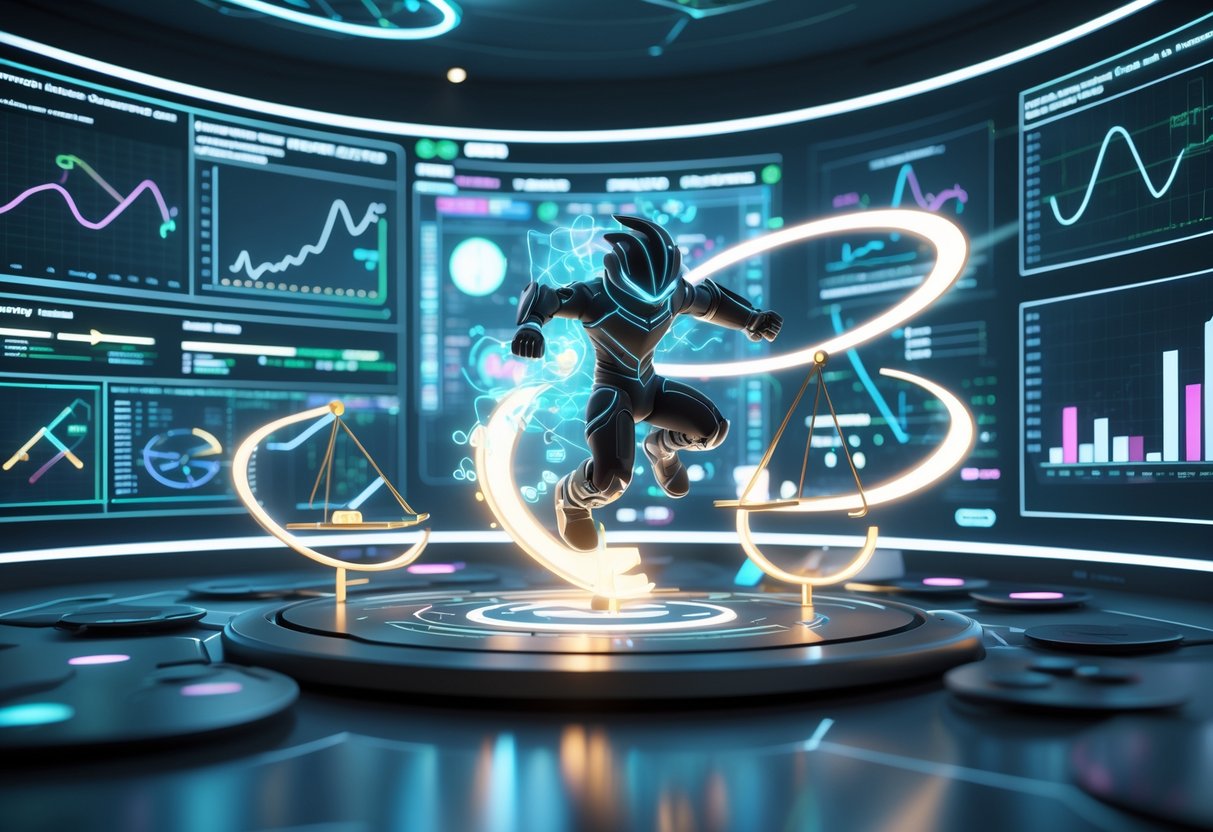Comeback Mechanics: Key Concepts, Impact, and Examples in Gaming
Updated On: October 26, 2025 by Aaron Connolly
Understanding Comeback Mechanics
Comeback mechanics are built-in features that help losing players catch up, but they aren’t just simple handicaps. Game designers weave them into competitive play, so they’re more than just a crutch.
Definition and Core Principles
A comeback mechanic gives players or teams who are behind a real shot at getting back into the match. These systems kick in only when you’re losing, offering extra power or chances that you don’t get when you’re ahead.
The core idea is pretty straightforward: the further behind you are, the more these mechanics help. In fighting games, taking hits might charge your meter faster. Mario Kart hands out wild items to the folks at the back of the pack.
What sets comeback mechanics apart is their conditional nature. They only show up when you need them most.
If you’re winning, you won’t get much—if anything—from these systems.
But here’s the thing: you still have to earn your comeback. The mechanics open the door, but you’ve got to walk through it with skill and timing.
Purpose in Competitive Play
Comeback mechanics do a few things for competitive gaming. They stop early leads from locking in a win, keep viewers glued to the action, and add layers of strategy.
Balance sits at the heart of it all. Without these systems, small early leads would just snowball, and matches would get boring fast.
Spectators love the drama. Watching a losing team claw back from the brink keeps people watching until the very end.
Strategically, these mechanics force the leader to stay sharp. You can’t just relax after getting ahead; you need to play smart, or your lead could vanish.
Gaming expert James Connolly once said, “the best comeback mechanics force winning players to make meaningful decisions rather than just playing it safe.” He’s got a point.
Distinction from Handicap Systems
Comeback mechanics and handicap systems aren’t the same thing. Handicaps show up before the match, but comeback mechanics pop up naturally as you play.
Handicap systems usually give the weaker player a head start. Think extra strokes in golf, a boost at the start of a race, or easier AI settings. Honestly, a lot of competitive players find these a bit fake.
Comeback mechanics blend right into the game’s DNA. Most players don’t even notice when they’re benefiting from them.
The psychological impact is pretty different, too. Handicaps can make a win feel empty. But with comeback mechanics, the losing player still has to outplay their opponent to turn things around.
So, the big difference? Handicaps set the stage before the battle, while comeback mechanics adapt to what’s actually happening in the match.
How Comeback Mechanics Work
Comeback mechanics kick in when players fall behind and give them specific tools to even things out. They set up risk-reward scenarios where the underdog gets a shot, but the leader has to defend their position carefully.
Activation Conditions
Most comeback mechanics trigger based on health, score, or resource gaps between players. In games like Tekken 7, the Rage system turns on when your health drops below a certain point, giving you a damage boost.
Team games often look at gold or experience differences. If a team falls way behind, the game might bump up the rewards for taking out the top players. Some games juggle several factors at once.
There are also objective-based triggers. If a team loses map control or falls behind on key objectives, the game might give them faster resource gain or special abilities.
The important thing is that these triggers need to be measurable and fair. Both sides get the same deal when the conditions hit.
Types and Variations
Resource-based mechanics are big in strategy games. Losing teams might get more gold per kill or level up faster, giving them a way back into the fight.
Ability boosts are another style. Sometimes, losing players get stronger attacks, shorter cooldowns, or faster movement until they close the gap.
Racing games do it differently. If you’re trailing, you might get speed boosts, while leaders deal with more obstacles or slower speeds. That keeps the race tight.
Some games use scaling mechanics. If you play patiently from behind, you might get stronger late-game options, so early leads don’t always decide everything.
Every type needs careful balance testing. If they’re too strong, early leads mean nothing. If they’re too weak, comebacks never happen.
Risk and Reward Dynamics
Good comeback mechanics don’t just hand out wins. If you’re behind, you still need to outplay your opponent to take advantage of the boost. Skill matters more than the system.
Shutdown bounties are a classic example. If you take out a leading player, you get a big reward—but that player is probably better equipped, so it’s a real risk.
Leaders have to decide between playing aggressive or playing it safe. Push too hard, and you might open the door for a comeback. Play too safe, and the game might let your opponent catch up naturally.
Timing is everything. Many comeback mechanics only last for a short window. You’ve got to spot the chance and act fast, or it’s gone.
The best systems keep both sides thinking and reacting. Leaders still control their fate, and underdogs have a real shot if they play well.
Comeback Mechanics in Fighting Games
Fighting games have been using mechanics to help losing players pull off wild reversals for years. These range from big super moves at low health to temporary buffs that can totally flip the match.
Key Examples in the Fighting Game Genre
Street Fighter IV brought modern comeback mechanics to the spotlight with its Ultra system. If your health dropped low enough, you got to fire off a huge attack with serious damage.
Marvel vs. Capcom 3’s X-Factor is infamous. It gives you more damage, speed, and even health regen when you pop it. The fewer characters you have left, the stronger it gets.
Tekken’s Rage system is another classic. When your health gets low, your attacks hit harder, and you unlock powerful Rage Arts that can steal a win out of nowhere.
You’ll find other comeback mechanics in big fighting games:
- Fatal Blows in Mortal Kombat – Only available at low health, but they hit like a truck
- Sparking in Dragon Ball FighterZ – Temporary team-wide power boost
- V-Trigger in Street Fighter V – Unique abilities that change up your character’s moves
Newer games like Street Fighter 6 have dialed these systems back. Critical Arts now get a small damage bump at low health, but nothing too wild.
Changing the Pace of Matches
Comeback mechanics totally change how matches feel. Even if you’re ahead, you can’t relax knowing your opponent has a reversal up their sleeve.
The psychology shifts. Players with the lead often get more defensive, while the underdog stays motivated because they know a comeback is possible.
The fighting game community has mixed feelings. Some competitive players say comeback mechanics reward sloppy play and make wins feel cheap.
But for spectators and casuals, those dramatic comebacks are what make matches memorable. The hype is real.
Lately, developers seem to prefer subtle systems. Guilty Gear Strive’s Guts system, for example, just reduces damage at low health instead of giving offensive boosts.
It looks like the trend is moving away from obvious comeback mechanics, but the idea of keeping matches close is still alive under the hood.
Iconic Fighting Game Comeback Mechanics
Two comeback mechanics have really left their mark on fighting games. X-Factor in Marvel vs. Capcom 3 gives a huge power-up to players on the ropes, while Tekken’s Rage system rewards risky, aggressive play when you’re nearly out.
X-Factor in Marvel vs. Capcom 3
X-Factor is one of the wildest comeback tools in fighting games. When you activate it, you get more damage, move faster, and even heal a bit over time.
If you’re down to your last character, X-Factor turns them into a monster. With a full team, it’s a small boost—alone, it’s game-changing.
How long X-Factor lasts:
- 3 characters left: 10 seconds
- 2 characters left: 15 seconds
- 1 character left: 20 seconds
You only get to use X-Factor once per match. Deciding when to use it can make or break a game. Sometimes, you’ll see a single fighter wipe out an entire team thanks to a well-timed X-Factor.
Players still argue about it. Some love the comeback hype, others think it gives too much to the losing side.
Rage in Tekken Series
Rage showed up in Tekken 6 and has stuck around ever since. When your health drops under 25%, you hit harder—about 10% more damage on everything.
You can’t miss it: your character glows red, and the health bar changes color. Both players know things can flip fast.
Rage System Perks:
- 10% more damage on all moves
- Unlocks Rage Arts (super-powerful special attacks)
- Better combo potential
- Puts pressure on the opponent
Tekken 8 went even further, adding Heat mechanics that work with Rage for even bigger plays.
Rage stays on until the round ends or you heal above the threshold. So instead of a quick burst, you feel the pressure for the rest of the fight.
If you keep your cool, Rage can turn things around. If your opponent panics, you can punish them for getting too comfortable with a big lead.
Standout Comeback Systems in Major Franchises

Some fighting games have shaped the way we think about competitive balance with unique comeback mechanics. These range from transformation states to risky, all-or-nothing attacks that can flip a match on its head.
Awakening Mode in Persona 4 Arena
Awakening Mode turns losing fighters into real threats once their health drops below 35%. The mode kicks in automatically, giving players a second wind.
When you awaken, you get a 40% defense buff to help you survive longer. You also get 100 SP right away for your super meter, opening up combo options you didn’t have before.
You can store more SP than usual in this mode, letting you pull off big super skills like Akihiko’s Maziodyne.
How to trigger Awakening:
- Health under 35%
- Character must be able to act
- Only works for normal characters (shadow versions miss out)
There’s some strategy here, too. You can force Awakening early using self-damage moves like Furious Action or Super Cancel, dodging long combos while vulnerable.
But if you’re stuck in a combo, you can’t awaken. That creates some nail-biting moments where players try to finish the job before their opponent gets another shot.
Pandora in Street Fighter X Tekken
Pandora stands out as one of the wildest risk-reward mechanics in fighting games. When your first character drops below 25% health, you can sacrifice them entirely to supercharge your last fighter.
The character you activate gets a big damage boost and moves a lot faster. Their special moves also become stronger and can break through defensive play.
But, Pandora comes with a cruel timer. You’ve got about 10 seconds to end the match. If you don’t finish your opponent before time runs out, you just lose—no matter how much health the other side has left.
Pandora Benefits:
- Big damage increase
- Faster movement
- Better special moves
- Scares your opponent
Honestly, the psychological effect can be just as important as the power boost. Opponents often panic when Pandora activates, and that’s when they mess up on defense.
Savvy players don’t just pop Pandora out of desperation. The best ones activate it when the opponent is already weak or stuck in a bad spot.
Ultra Combo in Street Fighter IV
Ultra Combos gave Street Fighter IV its signature comeback vibe thanks to the Revenge Gauge. This meter fills up as you take hits, and once it’s full, you can unleash a devastating super attack.
Each character gets to pick between two Ultras before the match. Some hit hard in one shot, while others are built for combos.
The gauge fills up faster if you take big hits. So, if you’re getting rushed down, you’ll build meter quickly, which actually helps balance things out a bit.
Ultra Combo Types:
- Massive single hit (Ryu’s Metsu Hadoken)
- Combo-friendly, multi-hit (Chun-Li’s Hosenka)
- Command grabs (Zangief’s Ultimate Atomic Buster)
- Utility-based (Vega’s Bloody High Claw)
Ultras aren’t just handed out—you need to nail the timing. If you mess up, you’re wide open for punishment.
The threat of an Ultra changes everything. Players with the lead play more carefully, while the ones behind get a real shot at turning things around.
Good players bait out Ultras and punish the whiffs. The whole dance around Ultras adds a layer of mind games to every match.
The Evolution of Comeback Mechanics

Tekken’s comeback systems have changed a ton over the years. Early tag games introduced Netsu Power, and later entries kept piling on new ideas for helping losing players get back in the fight.
Early Examples in Tekken Tag Tournament
Tekken Tag Tournament brought in some of the first real comeback mechanics for the series. You could swap between two characters, which gave you a fresh option whenever one was on the ropes.
The tag system itself worked as a basic comeback tool. If your main was struggling, you tagged in your partner with more health. That could flip the momentum in a flash.
Netsu Power was the game’s signature comeback mechanic. If one character took a beating, their partner would enter a rage state. Suddenly, they hit a lot harder and became much scarier.
The system kept things simple but effective. It gave the losing side a shot at extra damage without being totally busted. Plus, the visual cues made it obvious to everyone when Netsu was active.
Developments in Tekken Tag Tournament 2
Tekken Tag Tournament 2 took those ideas and made them more complex. Netsu Power came back, but now you had extra layers added in.
Rage Mode joined as a universal comeback mechanic. If a character’s health dropped below 25%, they got a damage boost. Both characters on a team could trigger this, so you had more chances for a comeback in every match.
Tag Assault combos made comebacks even more dangerous. You could spend meter to bring both fighters on screen for huge combo attacks. These could flip a match in seconds.
They also added Tag Crash, which let you break up your opponent’s combo by spending meter. That helped avoid those frustrating snowball situations where one combo spelled doom.
Comparisons Across Generations
Comeback mechanics got more complex over time. At first, Netsu Power was simple—take damage, get stronger. Later on, you had to think about when and how to use your comeback options.
| Game | Primary Mechanic | Complexity | Player Control |
|---|---|---|---|
| TTT1 | Netsu Power | Low | Automatic |
| TTT2 | Rage + Tag Systems | Medium | Player Choice |
Modern Tekken games keep pushing for more player-controlled comebacks. Developers moved from automatic triggers to tools you can use strategically, which feels like a win for players who want more skill expression.
The visuals got flashier too. Early Netsu just gave you more damage, but later games added wild effects and cool animations. It made comeback moments feel like a big deal.
Comeback Features Outside Fighting Games

Comeback mechanics pop up all over competitive gaming, not just in fighters. MOBAs and strategy games have their own ways to keep matches exciting. League of Legends actually set the standard for a lot of these systems.
Implementation in League of Legends
League of Legends uses several built-in comeback mechanics for teams that fall behind. The biggest one is bounty gold, which gives you extra gold if you take down a player on a hot streak.
When someone racks up several kills without dying, they’re worth more gold to the enemy team. If a player is on a five-kill streak, they give out 500 bonus gold instead of the usual 300. That makes dominating risky.
Objective bounties work the same way for teams. If one team gets a big gold lead, the other team can earn bonus gold from neutral monsters like dragons and Baron. The wider the gap, the bigger the bonus.
Minion waves also shift to help teams that are behind. If you’re losing, your minions push closer to your base, so it’s safer to farm and harder for the enemy to finish you off.
Experience catch-up mechanics let lower-level players gain XP faster if they take down higher-level enemies. So if a level 10 player beats a level 15, they get a big XP boost.
Case Studies in Other Competitive Titles
Dota 2 takes a different route. Teams that are behind get massive gold and experience bonuses for hero kills. A good teamfight can erase a 10,000 gold deficit almost instantly.
Valve actually stirred up the community when they increased these bonuses in 2014. Some players thought it made early leads pointless. After a lot of backlash, Valve dialed the bonuses back down.
Counter-Strike uses money to help comebacks. If a team keeps losing rounds, they get more cash each round (up to £3,400 per player). This “loss bonus” lets them buy better guns and stay in the fight.
Rocket League keeps things close with its boost system. Teams that are losing get boost pads that respawn faster, so they have more chances to defend or counterattack.
StarCraft II, on the other hand, got rid of most comeback mechanics on purpose. Blizzard wanted players who earned a lead to keep it through skill.
Impact on Competitive Balance and Game Design

Comeback mechanics shape how we experience competitive games and influence how developers think about balance. These systems affect player retention and can totally change the outcome of big tournaments.
Maintaining Player Engagement
When players fall behind early, they can lose motivation fast. Comeback mechanics give them a real shot at turning things around.
Fighting games have several tricks for this. Ultra combos in Street Fighter kick in when your health gets low. X-Factor in Marvel vs. Capcom 3 gets stronger as you lose teammates.
The fighting game community loves these moments. You never really know who’s going to win until the last second.
Key engagement benefits:
- Fewer early quits
- Streams stay exciting
- Tournament brackets get wild
- Players stay focused longer
Mario Kart’s blue shells are the classic example. Even if you’re in last place, you can still shake up the race. That keeps everyone fighting until the end.
Heads up: If comeback mechanics are too strong, players might actually sandbag on purpose just to get the advantage. That can backfire.
Influence on Tournament Outcomes
Tournament organizers and devs have to think carefully about how comeback mechanics affect fairness. These systems can create crazy upsets, which are fun to watch but sometimes frustrate pros.
FGC tournaments make this super clear. Some of the best EVO moments are huge comebacks made possible by these mechanics. Daigo’s famous parry wouldn’t have happened without specific systems allowing it.
Tournament impact factors:
- Prize distribution: More upsets mean less predictable payouts
- Seeding: Lower-ranked players can upset favorites
- Match length: Games can run long, which messes with broadcast schedules
- Skill expression: People argue about “earned” vs “artificial” wins
Take pool, for example. If you’re ahead, you get stuck with crowded tables and tough shots. If you’re behind, you get cleaner shots and more options.
Quick tip: Check out FGC tournament highlights for comeback mechanics in action. Listen to how the commentators hype up those moments.
Esports loves high viewership. Comeback mechanics ramp up the drama, keeping casual fans watching even when a match looks one-sided.
Debate and Community Perspectives

Players just can’t agree on comeback mechanics. Online forums are full of heated debates. The r/Fighters subreddit is basically the town square for these arguments in the fighting game world.
Controversies Among Players
The fighting game community is split. Some folks call comeback mechanics “clutch factors” that reward nerves of steel. Others slam them as “scrub mechanics” that cheapen real wins.
Pro-comeback arguments:
- Make for epic tournament moments
- Reward players who stay cool under pressure
- Stop matches from being total stomps
- Add more strategy to resource management
Anti-comeback arguments:
- Undercut early-game skill
- Feel fake, not “earned”
- Reward losing instead of skill
- Make matches less about actual talent
Even top players can’t agree. Some love these systems as part of modern fighters. Others wish games would go back to the old days.
Tournament results always spark more arguments. If someone wins with a comeback mechanic, people immediately question if they really deserved it.
Discussions in r/Fighters
The r/Fighters subreddit hosts these debates daily. Posts complaining about “comeback mechanics ruining fighting games” rack up hundreds of comments.
Common discussion topics:
| Topic | Community Split |
|---|---|
| V-Trigger in Street Fighter | 60% against, 40% for |
| Rage in Tekken | 70% for, 30% against |
| Burst mechanics | 80% for, 20% against |
New players often wonder if comeback mechanics make games easier. Veterans usually explain that using them well actually takes skill.
Polls show a generational divide. Younger players see comeback mechanics as normal. Old-school players, who grew up with arcade classics, are usually more skeptical.
Weekly threads break down specific games and their mechanics. These debates help people see where others are coming from in the community.
Design Principles and Balancing Approaches

Balancing comeback mechanics is tricky. Developers have to give trailing players hope without making things unfair for whoever’s ahead. The best systems feel like a natural part of the game, not something forced or punishing.
Creating Fair Play Opportunities
When we design comeback mechanics, we should make sure players feel like they’ve earned them, not just lucked into them. The best systems reward skill and strategy, not just someone falling behind.
Power scaling works when the player who’s losing gets stronger abilities. This keeps the competitive integrity intact, while still giving real chances to catch up.
Resource bonuses can help even things out. Some games toss extra cards, currency, or actions per turn to players who are behind. The bonus needs to matter, but it shouldn’t be so big that it flips the whole game.
Dynamic scoring systems open up comeback chances. If late-game objectives are worth more, skilled players can close the gap through smart play, not just a lucky break.
Turn order advantages can let trailing players act first each round. This offers a tactical edge without punishing the people who’ve been doing well.
We really shouldn’t punish players for playing well. If you’re winning, you shouldn’t feel like your success is working against you.
Avoiding Frustration in Competitive Settings
Comeback mechanics can go wrong if they feel forced or unfair. We want to avoid making the leader feel like they’re being targeted.
Transparent systems work best for competitive games. Players need to know exactly how catch-up mechanics work. Hidden bonuses just breed suspicion and frustration.
Time limits can stop comeback mechanics from dragging games out forever. No one wants to feel stuck in a losing position for ages.
Skill-based triggers keep things fair. Comeback bonuses should reward good play, not just random luck or bad performance.
We need to test with competitive players. They’ll spot broken systems or unfair advantages right away.
Balance testing should include players of all skill levels. What feels fair to casuals might annoy hardcore competitors—or the other way around.
Tournaments show if comeback mechanics actually make games better. Feedback from these events helps us tweak things as needed.
Related Mechanics and Theories

Comeback mechanics work differently from snowball mechanics. They usually rely on systems like super meters or critical status buffs. These keep matches close and exciting, but don’t erase early leads entirely.
Distinction from Snowball Mechanics
Snowball mechanics do the opposite of comeback tools. If you’re ahead, snowball mechanics make you even stronger.
It’s like a snowball rolling downhill—it just gets bigger and faster. In games, this means early leads can snowball into huge advantages.
Key differences:
- Snowball mechanics: Early success leads to more success
- Comeback mechanics: Falling behind gives you tools to catch up
- Snowball focus: Rewards the leader
- Comeback focus: Helps the player who’s losing
Most competitive games blend both. That way, you get tension between early aggression and late-game heroics.
Snowball mechanics make people fight for early leads. Comeback mechanics keep things interesting even if one side is losing.
How these systems balance each other really shapes the whole game. Too much snowball, and matches get dull once someone’s ahead. Too much comeback, and the early game stops mattering.
Role of Super Meter and Critical Status Buffs
Super meters are classic comeback tools in fighting games. Your meter fills up faster when you’re losing health or rounds.
When you’re almost out, you get to use super moves more often. That gives you a shot at turning things around with a big play.
Modern fighting games like Street Fighter 6 use this idea. Your super meter builds quicker at low health, but it doesn’t just hand you the win.
Critical status buffs kick in during dangerous moments. These can include:
- Extra damage when your health drops below 25%
- Faster ability cooldowns if you’re on a losing streak
- Temporary shields or damage reduction
- Speed boosts when you’re behind
These buffs give losing players a chance to make big moves. But you still have to outplay your opponent to win.
The trick is making buffs strong enough to help, but not so strong that they guarantee a comeback. Players should feel like they earned it, not like the game just handed them a win.
Frequently Asked Questions

People usually ask how games add comeback features, how balance updates affect them, and what strategies help players use them well. They also want to know about things like rubber-banding and see real examples from popular games.
What are typical ways that a game introduces elements that help players who are behind?
Games use a few common tricks to help losing players catch up. The most popular is scaling rewards based on how far behind someone is.
Mario Kart’s blue shell targets whoever’s in first. That gives players in the back a powerful weapon, while the leader gets nothing similar.
Fighting games often have ultra meters that fill up quicker when you’re losing health. Street Fighter’s Ultra Combos and Marvel vs Capcom’s X-Factor both activate when you’re in trouble.
Strategy games sometimes hand out bonus resources to players who are struggling. Age of Empires gives extra villagers to losing civilizations, and League of Legends offers bounty gold for taking down fed opponents.
Some games use positional advantages. In racing games, players who did badly in the last race might get better starting spots next time.
How do balance changes affect the efficacy of catch-up features in competitive games?
Balance updates can totally change how comeback mechanics work. Developers tweak these systems all the time based on player feedback and match stats.
League of Legends often adjusts bounty amounts and when they kick in. If too many games end in comebacks, they cut the gold rewards. If early leads get too strong, they boost the catch-up bonuses.
Fighting games sometimes nerf comeback mechanics if they get too strong. Street Fighter has lowered Ultra damage more than once after complaints about “random” comeback wins.
The big challenge is finding the right balance. If comeback tools are too weak, early leads become impossible to overcome. If they’re too strong, early-game skill stops mattering.
Developers keep an eye on win rates at different points in the game. If teams with a big gold lead still lose a lot, the comeback mechanics might be a bit too generous.
Can you explain how rubber-banding functions in racing games?
Rubber-banding keeps racers close together, almost like they’re tied by elastic bands. This stops anyone from running away with the win.
Trailing racers get slight speed boosts, while the leader gets slowed down a bit. You probably won’t notice it while playing, but it keeps the race tight.
Mario Kart uses pretty aggressive rubber-banding, plus powerful items for players in the back. The leader gets weaker defensive options.
More realistic racing games use it more subtly. They might slow down AI opponents, rather than boosting the player directly.
Some racing games skip rubber-banding in competitive modes. F1 games usually turn off these assists for esports tournaments.
What strategies are recommended for players to effectively utilise catch-up features?
Patience is key when you’re behind. Comeback mechanics only work if you survive long enough to use them.
Play defensively until your comeback chance shows up. In fighting games, that means blocking more and taking fewer risks while your ultra meter fills.
Learn to spot when comeback mechanics are active. In League of Legends, for example, bounty icons pop up over fed enemies, marking them as high-value targets.
Work with your teammates to make the most of comeback rewards. If five people split a bounty, it helps less than if your main damage dealer picks it up.
Don’t lean too hard on comeback mechanics. They open doors, but you still have to execute well to walk through them.
Practice helps a ton. Spend time learning your character’s comeback tools in training mode before using them in ranked matches.
How does player feedback typically influence the adjustment of catch-up mechanics in multiplayer environments?
Player complaints shape most changes to comeback mechanics. Developers keep an eye on forums, social media, and feedback tools for common gripes.
The top complaint? That comeback mechanics feel “unfair” to players who are winning. If skilled players keep losing despite early leads, developers usually dial things back.
Riot Games often explains changes to League of Legends bounties, sharing stats and their reasoning behind tweaks.
Pro players have extra influence. When tournament competitors call comeback mechanics too random, developers sometimes make special competitive rules.
Community surveys give a broader picture. If most players hate a mechanic, it’s probably time for a change.
Beta tests help developers gather feedback before rolling out big changes. Players can try out new comeback systems and point out problems.
Could you share examples of popular games that have successfully implemented catch-up mechanics?
Mario Kart really sets the bar for comeback mechanics. Blue shells pop up and shake things up, but they don’t totally wipe out skilled play.
Super Smash Bros. Ultimate throws in rage mechanics. When your damage gets high, your knockback increases, so suddenly you’ve got a real shot at turning things around.
League of Legends uses a bounty system. If you take down a fed opponent, you grab extra gold. Teams can pull back from early setbacks by focusing their attacks on the right targets.
Tekken brings in rage arts when your health dips below 25%. Land one of these and you can flip a match on its head with a single solid read.
Hearthstone gives players discover mechanics. If you’re behind, sometimes you draw better card options and get a chance to even things out. It’s not strictly a comeback tool, but it does help keep games interesting.
Street Fighter 6’s drive system lets players spend meter for enhanced moves or defense. If you’re under pressure, you can escape or hit back harder, which keeps the fight alive for longer.

